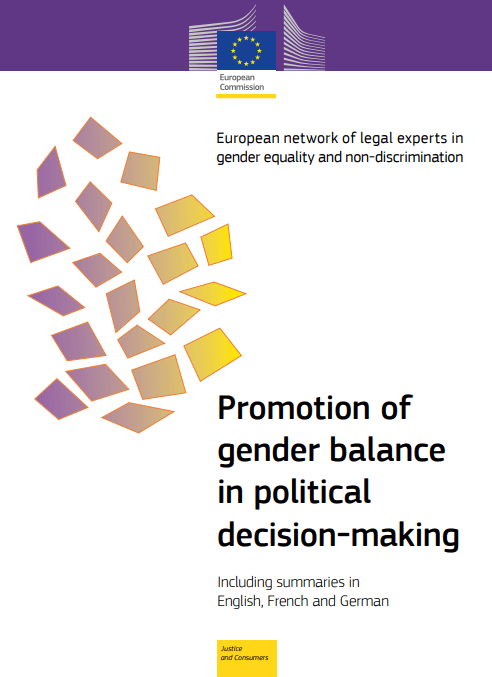Promotion of gender balance in political decision-making, 2023

This thematic report is a study on the promotion of gender-balanced political decision-making in the 27 EU Member States, Iceland, Norway, Liechtenstein and the UK.
Prepared by BILJANA KOTEVSKA, VERA PAVLOUFOR for the European network of legal experts in gender equality and non-discrimination.
Publication date: 8 March 2023.
Topics: Employment; Gender; Gender equality; Social advantages; Violence against women.
Contents
EXECUTIVE SUMMARY, p. 7
RÉSUMÉ, p. 12
ZUSAMMENFASSUNG, p. 18
1. INTRODUCTION, p. 24
1.1 Context and scope, p. 24
1.2 Key concepts, p. 25
1.3 Methodology, p. 26
1.4 Structure of the report, p. 27
2. INTERNATIONAL AND REGIONAL STANDARDS, p. 28
2.1 Introduction, p. 28
2.2 United Nations, p. 29
2.3 Council of Europe, p. 34
2.4 Organization for Security and Co-operation in Europe, p. 38
2.5 European Union, p. 39
2.6 Conclusion, p. 42
3. ELECTIONS, p. 44
3.1 Introduction, p. 44
3.2 Legislation and policies mandating or encouraging gender balance in the leadership of political parties, p. 44
3.3 Selecting candidates for national, regional and local elections: law and policies, p. 45
3.4 Gender balance in the selection for candidates by political parties for the EU Parliament elections, p. 47
3.5 Gender balance in the composition of electoral management bodies and observer commissions, p. 48
3.6 Encouraging women to vote, p. 48
3.7 The enforcement and effectiveness of legislative frameworks encouraging gender balance in elections, p. 50
3.8 Violations of women’s active and passive voting rights, p. 53
3.9 Existence of official mechanisms/authorities tasked to monitor sexism and sexist hate speech in electoral campaigns, p. 55
3.10 Sanctions and other consequences prescribed for sexism and sexist hate speech in electoral campaigns, p. 56
3.11 Conclusion, p. 56
4. THE LEGISLATURE, p. 58
4.1 Introduction, p. 58
4.2 Positive action for the promotion of women in decision-making positions in the legislature, p. 58
4.3 Measures for institutional and cultural transformation, p. 63
4.4 Measures aimed at women from minority groups, p. 66
4.5 Obstacles, p. 69
4.6 Other activities for the promotion of women in decision making in the legislature, p. 71
4.7 Relevant case law, p. 73
4.8 Internal regulation and sanctioning of harassment and sexual harassment, p. 75
4.9 Violence against women in decision-making positions in the legislature, p. 78
4.10 Data collection on gender balance in public decision-making positions in the legislature, p. 82
4.11 Conclusion, p. 86
5. EXECUTIVE, p. 87
5.1 Introduction, p. 87
5.2 Measures for the promotion of women in decision-making positions in the executive, p. 87
5.2.1 Legally binding measures, p. 87
5.2.2 State policies and other non-binding measures, p. 91
5.3 Measures for institutional and culture transformation for the promotion of gender balance in decision-making positions in the executive, p. 91
5.4 Mechanisms for the involvement and participation in decision making in the executive for minority women, p. 93
5.5 Soft or hard law measures/provisions creating an obstacle for gender equality or hindering women’s participation in the executive, p. 94
5.6 Effectiveness of measures, p. 95
5.7 Case law on quotas or other measures, p. 96
5.8 Internal mechanisms and procedures against gender-based discrimination and harassment, p. 98
5.9 State institutions tasked with data collection on gender balance in public decision-making positions in the executive, p. 98
5.10 Conclusion, p. 99
6. PUBLIC ENTERPRISES, p. 100
6.1 Introduction, p. 100
6.2 Positive action for promotion of gender balance in decision-making positions in public enterprises, p. 100
6.3 Measures aimed at women from minority groups in public enterprises, p. 105
6.4 Internal regulation and sanctioning of harassment and sexual harassment in public enterprises, p. 106
6.5 Data collection on gender balance in public decision-making positions in public enterprises, p. 108
6.6 Conclusion, p. 111
7. GOOD PRACTICES, p. 113
7.1 Introduction, p. 113
7.2 Quotas, p. 113
7.3 Public awareness raising, p. 115
7.4 Shortlisting, p. 116
7.5 Corrective mechanisms, p. 116
7.6 Long-term, sustained efforts towards building a gender equality culture, p. 116
7.7 Strategic approach to institutional and culture transformation: action programmes and gender audit, p. 117
7.8 Private-work life balance measures: predictable schedules, calendars, voting adjustments, paid leave, infrastructure interventions, p. 117
7.9 Harassment and sexual harassment complaints mechanisms, p. 119
7.10 Equal Treatment Coordinators, p. 119
7.11 Promoting women at special minority elections, p. 120
7.12 Soft regulation and support: certification, good practice guide, transparency, p. 120
8. CONCLUSIONS AND RECOMMENDATIONS, p. 121
8.1 Conclusions, p. 121
8.2 Ways forward, p. 124
ANNEX: QUESTIONNAIRE ON PROMOTION OF GENDER BALANCE IN POLITICAL DECISION-MAKING, p. 127




